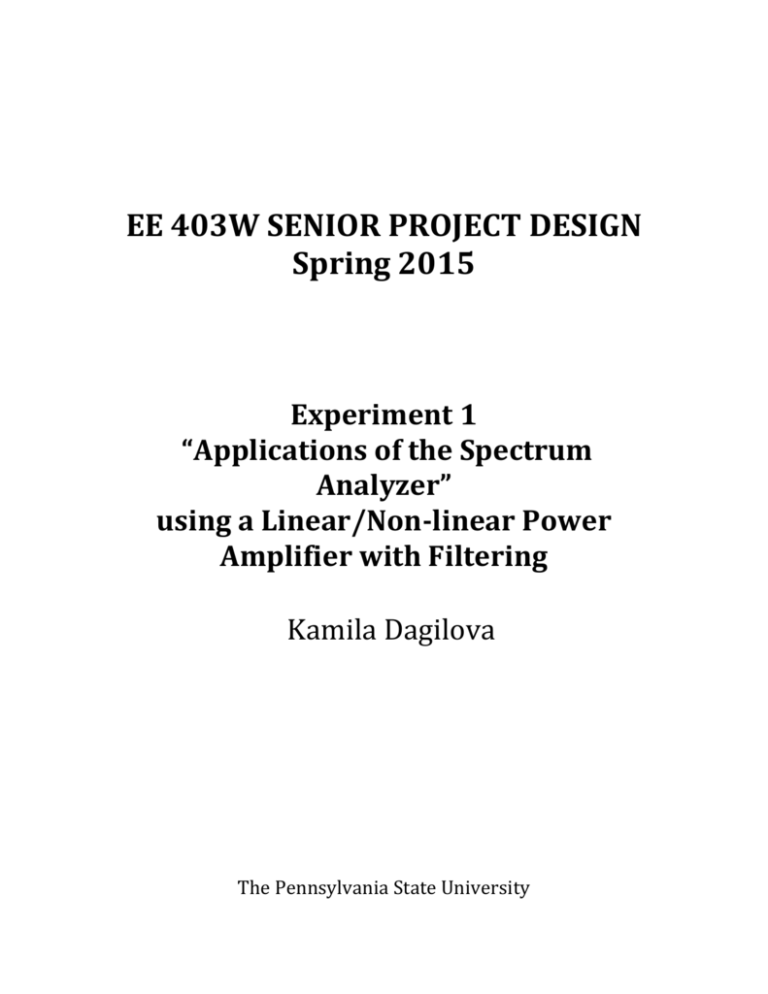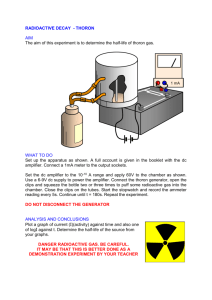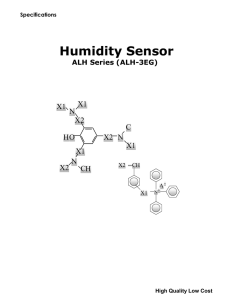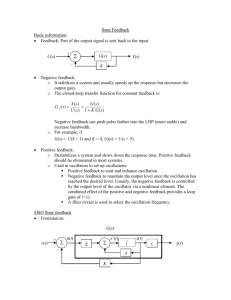ee 403w senior project design
advertisement

EE 403W SENIOR PROJECT DESIGN Spring 2015 Experiment 1 “Applications of the Spectrum Analyzer” using a Linear/Non-linear Power Amplifier with Filtering Kamila Dagilova The Pennsylvania State University 2 Kamila Dagilova EE403W Experiment 1 Spring 2015 Table of Contents INTRODUCTION ........................................................................................................................................ 3 PART A – WAVEFORM ANALYSIS........................................................................................................ 3 PART-B – MEASUREMENT OF A LINEAR/NON-LINEAR POWER AMPLIFIER WITH FILTERING .................................................................................................................................................. 5 PART B1 ....................................................................................................................................................................6 PART B2 ................................................................................................................................................................. 10 PART B3 ................................................................................................................................................................. 11 PART B4 ................................................................................................................................................................. 15 PART B5 ................................................................................................................................................................. 17 PART B6 ................................................................................................................................................................. 20 APPENDIX ................................................................................................................................................ 22 Kamila Dagilova EE403W Experiment 1 Spring 2015 3 INTRODUCTION The purpose of this experiment is to become familiar with the use and applications of the spectrum analyzer. Spectrum analyzer is a tool that helps to observe and measure electrical signals in frequency domain. It presents information (e.g. about distortions) that is sometimes impossible to see in the time domain. In part A of the experiment we need to capture amplitude spectra of two waveforms – the sine and square waves. In part B we need to use a pre-built 1 watt Linear/NonLinear Power Amplifier with filtering to generate distortions in class AB and Class B operation modes. PART A – WAVEFORM ANALYSIS Our first task was to produce amplitude spectra of the sine and square waves outputs with the help of HP function generator. The range of frequencies should include at least the tenth harmonic. After we set the generator to produce a 1 Vp sine wave at a frequency 10 kHz, we then measured the amplitude on the oscilloscope, which was 2.05 Vpp because the function generator output was expecting a 50 Ohm load, but our oscilloscope was in High z mode. After adjusting the generator to produce a signal of 1 V peak at the oscilloscope input, we captured an image (Figure 1) with a span of 10 harmonics. When we changed the generator’s waveform to square wave the peaks on the spectrum analyzer became more distinct (Figure 2.) For the last steps of part A we used the Fourier series expansion for a square wave that predicted the amplitude for each spectral component in the square wave, noting that the amplitudes of even harmonics equal zero. By normalizing the harmonic amplitudes to the amplitude of the fundamental (then 3rd, 5th, etc.) we obtain relative amplitudes, which can also be expressed in decibels, by using the relationship dB = 20log(1/n) (where n is odd). The results can be seen in Table 1. 4 Kamila Dagilova EE403W Experiment 1 Figure 1 Figure 2 Spring 2015 Kamila Dagilova EE403W Experiment 1 n F (kHz) 1 2 3 4 5 6 7 8 9 10 20 30 40 50 60 70 80 90 Spring 2015 5 Amplitude (Vp)=Vrms 4A/pi 0 4A/3pi 0 4A/5pi 0 4A/7pi 0 4A/9pi Relative (Vp) 1 0 1/3 0 1/5 0 1/7 0 1/9 Amplitude (dB) 0 -9.54 13.979 -16.90 -19.08 Table 1 PART-B – MEASUREMENT OF A LINEAR/NON-LINEAR POWER AMPLIFIER WITH FILTERING For this portion of the lab we use a Pre-built 1-Watt Linear/Non-linear Amplifier with filtering and the Oscilloscope/Spectrum analyzer to examine the distortions produced by this amplifier in both Class AB and Class B operation modes. The amplifier’s schematic, board layout, to which we referred to, as well as the bill of materials can be found in Appendix. The goal of the circuit is to deliver 1 watt to an 8 Ohm load, avoiding excessive distortions. Here are the requirements: 6 Kamila Dagilova EE403W Experiment 1 Spring 2015 We use the Stage 2 of the amplifier, which is Class AB/Class B configuration, because Stage 1 (Broadband linear/non-linear inverting amplifier or a tuned linear/non-linear inverting amplifier or an active low pass filter inverting amplifier) cannot deliver enough output current to drive the load directly. As we will observe later, a stage-2 in the Class B mode configuration displays a phenomenon known as crossover distortion because of the non-conducting (dead) zone of 00.7 V of the bipolar transistor. Part B1 For Configuration #1 (Broad band power amplifier) shown in Figure 3, we need to determine the following: a) The circuit’s natural -3dB (Gain = 0.707 of the Maximum Value) Cutoff frequency (Fc) with the gain adjust knob of RP1 set in the Full Clockwise 0 Ohm Position (R = R3+RP1=1 kOhm + 0 kOhm = 1 kOhm) b) The circuit’s natural -3dB (Gain = 0.707 of the Maximum Value) Cutoff frequency (Fc) with the gain adjust knob of RP1 set in the Full Counter-clockwise 10 kOhm Position (R = R3+RP1=1 kOhm + 10 kOhm = 11 kOhm) c) The FFT spectrum plot using the Oscilloscope’s FFt function under the conditions described above. Figure 3 Following the steps 1-18 we have recorded the results to the engineering notebook. Step 6 determines the circuits natural -3dB (Gain = 0.707 of the Maximum Value) Cutoff frequency (Fc) with the gain adjust knob of RP1 set in the Full Clockwise 0 Ohm Position (R = R3+RP1=1 kOhm + 0 kOhm = 1 kOhm), which is 3.67 MHz under which Kamila Dagilova EE403W Experiment 1 Spring 2015 7 the output sine wave (channel 2) is distorted (amplifier’s limit) (Figure 4.) Figure 4 In step 8, we get the frequency value, which is 2.69 MHz - the circuits natural -3dB (Gain = 0.707 of the Maximum Value) Cutoff frequency (Fc) with the gain adjust knob of RP1 set in the Full Counter-clockwise 10 kOhm Position (R = R3+RP1=1 kOhm + 10 kOhm = 11 kOhm) (Figure 5.) 8 Kamila Dagilova EE403W Experiment 1 Spring 2015 Figure 5 After completing the adjustments in steps 12-14 (WaveTek set up) we reconnected HP generator (Figure 6), switched the Oscilloscope to FFT mode and adjusted the Frequency and Amplitude settings to display as many harmonics as possible (Figure 7). Figures 8 and 9 show the plots of the output wave due to HP/WaveTek generator alone, after we remove the BNC cable connected to J2/J1 of the Power Amplifier. Figure 6 Kamila Dagilova EE403W Experiment 1 Figure 7 Figure 8 Spring 2015 9 1 0 Kamila Dagilova EE403W Experiment 1 Spring 2015 Figure 9 Part B2 For Configuration #2 (Broad band power amplifier) shown in Figure 10, we need to repeat steps 15-18 of Part B1, the images of the results of steps 15, 16, 17, 18 are shown in Figures 11, 12, 13, 14 accordingly. Figure 10 Kamila Dagilova EE403W Experiment 1 1 Spring 2015 1 Figure 11 Figure 12 Figure 13 Figure 14 Part B3 For Configuration #3 (Active Low-Pass Filter power amplifier) shown in Figure 15, we need to determine the following: a) The circuit’s natural -3dB (Gain = 0.707 of the Maximum Value) Cutoff frequency (Fc) with the gain adjust knob of RP1 set in the Full Clockwise 0 Ohm Position (R = R3+RP1=1 kOhm + 0 kOhm = 1 kOhm) b) The circuit’s natural -3dB (Gain = 0.707 of the Maximum Value) Cutoff frequency (Fc) with the gain adjust knob of RP1 set in the Full Counter-clockwise 10 kOhm Position (R = R3+RP1=1 kOhm + 10 kOhm = 11 kOhm) 1 2 Kamila Dagilova EE403W Experiment 1 Spring 2015 c) The FFT spectrum plot using the Oscilloscope’s FFt function under the conditions described above. d) The calculated value of Fc for this Amplifier in Engineering notebook. Figure 15 The results of steps 1-18 were recorded to the engineering notebook. Step 6 determines the circuits natural -3dB (Gain = 0.707 of the Maximum Value) Cutoff frequency (Fc) with the gain adjust knob of RP1 set in the Full Clockwise 0 Ohm Position (R = R3+RP1=1 kOhm + 0 kOhm = 1 kOhm), which is approximately 180 kHz with the output V ~5.6 V (Figure 16.) The result is not much different from the calculated value, which was 160 kHz by formula Fc = 1/(2pi*R*Ct) (with Ct=1e-9F, R = 1 KOhm). Figure 16 In step 8, we get the frequency value, which is ~17 kHz - the circuits natural -3dB (Gain = 0.707 of the Maximum Value) Cutoff frequency (Fc) Kamila Dagilova EE403W Experiment 1 1 Spring 2015 3 with the gain adjust knob of RP1 set in the Full Counter-clockwise 10 kOhm Position (R = R3+RP1=1 kOhm + 10 kOhm = 11 kOhm) (Figure 17.) The result is not much different from the calculated value, which was 14.476 kHz by formula Fc = 1/(2pi*R*Ct) (with Ct=1e-9F, R = 11 KOhm). Figure 17 After completing the adjustments in steps 12-14 (WaveTek set up) we reconnected HP generator (Figure 18), switched the Oscilloscope to FFT mode and adjusted the Frequency and Amplitude settings to display as many harmonics as possible (Figure 19). Figures 20 shows the plot of the output wave due to WaveTek generator alone, after we remove the BNC cable connected to J1 of the Power Amplifier. (Due to incorrect brightness settings some of our waveforms are not bright, and we noticed that later.) 1 4 Kamila Dagilova EE403W Experiment 1 Figure 18 Figure 19 Figure 20 Spring 2015 Kamila Dagilova EE403W Experiment 1 1 Spring 2015 5 Part B4 For Configuration #4 (Active Low-Pass Filter power amplifier) shown in Figure 21, we need to repeat steps 15-18 of Part B3, the images of the results of steps 15, 16, 17, 18 are shown in Figures 22, 23, 24, 25 accordingly. Figure 21 Figure 22 1 6 Kamila Dagilova EE403W Experiment 1 Spring 2015 Figure 23 Figure 24 Kamila Dagilova EE403W Experiment 1 1 Spring 2015 7 Figure 25 Part B5 For Configuration #5 (Tuned power amplifier) shown in Figure 26, we need to determine the following: a) The second order circuit’s 2 natural -3dB (Gain = 0.707 of the Maximum Value) Cutoff frequencies (FCL and FCU) with the gain adjust knob of RP1 set in the Full Clockwise 0 Ohm Position (R = R3+RP1=1 kOhm + 0 kOhm = 1 kOhm) b) The second order circuit’s 2 natural -3dB (Gain = 0.707 of the Maximum Value) Cutoff frequency (Fc) with the gain adjust knob of RP1 set in the Full Counter-clockwise 10 kOhm Position (R = R3+RP1=1 kOhm + 10 kOhm = 11 kOhm) c) The FFT spectrum plot using the Oscilloscope’s FFt function under the conditions described above. d) The calculated value of Resonant frequency for this Amplifier in Engineering notebook. 1 8 Kamila Dagilova EE403W Experiment 1 Spring 2015 Figure 26 The results of steps 1-18 were recorded to the engineering notebook. Step 6 determines the second order circuit’s 2 natural -3dB (Gain = 0.707 of the Maximum Value) Cutoff frequencies (FCL and FCU) with the gain adjust knob of RP1 set in the Full Clockwise 0 Ohm Position (R = R3+RP1=1 kOhm + 0 kOhm = 1 kOhm) which are approximately 0.93MHz and 1.13 MHz (Figure 27.) In step 8, we get the second order circuit’s 2 natural -3dB (Gain = 0.707 of the Maximum Value) Cutoff frequency (Fc) with the gain adjust knob of RP1 set in the Full Counterclockwise 10 kOhm Position (R = R3+RP1=1 kOhm + 10 kOhm = 11 kOhm, the range of which is 0.903 kHz – 1.064 kHz (Figure 28.) After completing the adjustments in steps 12-14 (WaveTek set up) we reconnected HP generator (Figure 29), switched the Oscilloscope to FFT mode and adjusted the Frequency and Amplitude settings to display as many harmonics as possible (Figure 30). Figures 31 and 32 show the plots of the output wave due to HP/WaveTek generator alone, after we remove the BNC cable connected to J2/J1 of the Power Amplifier. The calculated value for resonant frequency is 1.007 MHz – obtained by formula Fr = 1/(2pi*sqrt(LtCt)) with Ct = 1e-9 F, and Lt = 25e6 Henrys. Kamila Dagilova EE403W Experiment 1 Figure 27 Figure 28 1 Spring 2015 9 2 0 Kamila Dagilova EE403W Experiment 1 Spring 2015 Figure 29 Figure 30 Figure 31 Figure 32 Part B6 For Configuration #6 (Tuned power amplifier) shown in Figure 33, we need to repeat steps 15-18 of Part B5, the images of the results of steps 15, 16, 17, 18 are shown in Figures 34, 35, 36, 37 accordingly. All necessary calculations are recorded in the lab notebook. Kamila Dagilova EE403W Experiment 1 2 Spring 2015 1 Figure 33 Figure 34 Figure 35 Figure 36 Figure 37 2 2 Kamila Dagilova EE403W Experiment 1 APPENDIX Spring 2015 Kamila Dagilova EE403W Experiment 1 2 Spring 2015 3 2 4 Kamila Dagilova EE403W Experiment 1 Spring 2015








